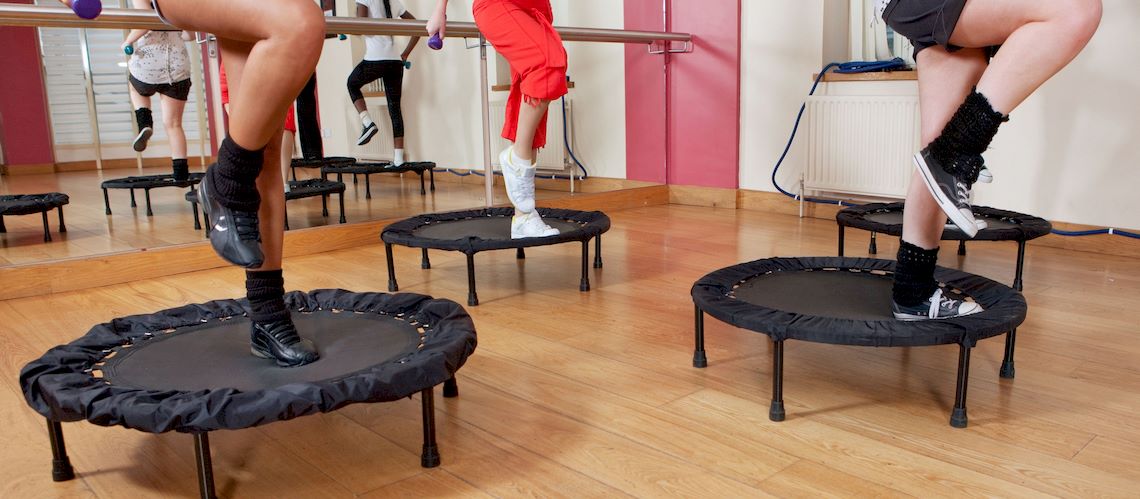Rebounding, or trampoline exercise, is a rhythmic, low-impact workout performed on a mini-trampoline. It is not merely a physical activity; it offers physical, mental, emotional, and spiritual benefits, aligning seamlessly with the Excellence Nexus framework. This framework focuses on achieving peak performance across interconnected dimensions of life. By synthesizing scientific insights and practical applications, this article demonstrates how rebounding supports each peak of excellence.
1. Physical Peak: Building Vitality and Strength
The physical peak in the Excellence Nexus emphasizes vitality, functional strength, and resilience. Rebounding supports these outcomes through cardiovascular benefits, balance improvements, and reduced joint strain.
Cardiovascular Health
NASA’s research on rebounding, conducted by Bhattacharya et al. (1980), demonstrated its efficiency in improving oxygen uptake while minimizing joint strain, making it a highly suitable exercise for maintaining cardiovascular health. Complementing this, Smith and Bishop (1988) identified notable aerobic benefits of rebounding, emphasizing that its cardiovascular efficacy depends on maintaining appropriate intensity and duration within structured routines. Supporting these findings, Cugusi et al. (2018) highlighted significant enhancements in cardiovascular endurance through mini-trampoline rebounding, including increased VO₂ max and reductions in both systolic and diastolic blood pressure. Together, these studies underscore rebounding’s potential as a joint-friendly, effective, and versatile option for improving cardiovascular fitness, particularly for individuals with physical limitations.
Improved Balance and Coordination
Rebounding engages stabilizing muscles in the core and lower limbs, improving balance and coordination. As Rogers et al. (2003) note, balance exercises, including dynamic movements like rebounding, can enhance proprioception and reduce fall risk in older adults. This capacity to refine motor skills is equally valuable for athletes, who benefit from improved agility and functional movement.
Joint-Friendly Strengthening
Unlike high-impact exercises such as running, rebounding minimizes mechanical stress on joints while engaging key muscle groups. Carter (1980) highlights the repetitive and multidirectional nature of rebounding, which strengthens muscles without excessive strain. This makes it a suitable option for individuals with joint sensitivities or recovering from injuries.
Through these mechanisms, rebounding fosters physical vitality, strength, and resilience—key elements of peak physical performance.
2. Mental Peak: Enhancing Clarity and Focus
The mental peak emphasizes cognitive clarity, focus, and adaptability. Rebounding stimulates the mind by requiring coordination, rhythm, and balance.
Cognitive Stimulation Through Movement
The dynamic adjustments necessary during rebounding activate neural pathways associated with coordination and adaptability. Rogers et al. (2003) emphasize that proprioceptive activities challenge the brain’s capacity to process spatial information, potentially enhancing focus and problem-solving skills.
Flow State and Relaxation
Rebounding’s rhythmic and repetitive nature creates conditions conducive to achieving a flow state, characterized by intense focus and immersion. This state, as described by Csikszentmihalyi, fosters creativity and satisfaction. Although rebounding-specific studies are limited, its simplicity and repetitive movements suggest it is a promising avenue for achieving flow.
Stress Buffering
Rebounding requires concentration on movement, providing a mental break from stressors. Brooks (2003) emphasizes its role in reducing stress and promoting mental relaxation, contributing to resilience and recovery.
By engaging the mind and fostering mental clarity, rebounding supports cognitive peak performance within the Excellence Nexus framework.
3. Emotional Peak: Regulating Mood and Enhancing Resilience
The emotional peak encompasses mood stability, stress reduction, and resilience. Rebounding’s rhythmic and engaging qualities offer significant emotional benefits.
Mood Enhancement
Exercise is widely recognized for stimulating endorphins—natural chemicals that promote a positive mood. Wegner et al. (2014) review the impact of physical activity on anxiety and depression, highlighting its therapeutic potential. Rebounding fits within this paradigm, offering an enjoyable way to alleviate stress and enhance emotional resilience.
Engagement and Enjoyment
Carter (1980) describes rebounding as a joyful activity, fostering adherence and emotional well-being. Its low-impact nature makes it accessible to a broad range of participants, encouraging consistency and long-term benefits.
Tension Release
The rhythmic motion of rebounding helps release stored physical tension. This physical release is often accompanied by psychological relaxation, as Brooks (2003) notes, reinforcing its value for managing emotional stress.
By consistently practicing rebounding, individuals can cultivate emotional stability and resilience, key to navigating life’s challenges.
4. Spiritual Peak: Fostering Connection and Harmony
The spiritual peak focuses on achieving alignment between mind, body, and spirit. Rebounding’s meditative and rhythmic qualities suggest its potential for fostering mindfulness and inner peace.
Mindfulness in Motion
Rebounding’s repetitive movements encourage synchronization of breath and action, promoting mindfulness. Brooks (2003) highlights how this synchronization fosters self-awareness and a sense of harmony, aligning physical activity with mental and spiritual intentions.
Enhancing the Mind-Body Connection
Balance and coordination exercises deepen the connection between body and mind. This integration fosters introspection, creating opportunities for spiritual growth. Carter (1980) describes rebounding as a practice that enhances physical and spiritual alignment.
Facilitating Inner Peace
Participants often report feelings of calmness and centeredness following rebounding sessions (Carter, 1980). While empirical evidence remains sparse, anecdotal accounts suggest its potential for fostering harmony and mindfulness.
By incorporating mindfulness into rebounding routines, individuals can transform a simple workout into a meaningful spiritual practice, supporting holistic growth and well-being.
Connecting the Peaks to the Excellence Nexus
Each peak—physical, mental, emotional, and spiritual—represents a vital dimension of the Excellence Nexus framework. Together, they form the foundation for a balanced and thriving life. While the Leadership peak and Impact peak may not appear directly connected to rebounding, the benefits cultivated through this practice do not exist in isolation. Instead, they resonate across all aspects of our being, creating a ripple effect that enhances our capacity to lead and to make a meaningful impact on others. By aligning vitality, clarity, emotional stability, and spiritual harmony, rebounding contributes to the holistic synergy that fuels excellence in all areas.
Practical Applications for the Excellence Nexus
- Establish a Consistent Routine: Start with 10–15 minutes of rebounding 3–4 times per week. Gradually increase duration and intensity.
- Challenge Balance and Coordination: Add advanced movements like twisting jumps, one-legged bounces, or jogging in place.
- Focus on Mindfulness: Pay attention to your breath and movement rhythm during rebounding sessions.
- Pair with Complementary Practices: Combine rebounding with yoga, meditation, or strength training for holistic benefits.
- Reflect and Monitor Progress: Keep a journal to track improvements in cardiovascular fitness, mental clarity, emotional stability, and spiritual awareness.
Conclusion
Rebounding is a dynamic, versatile exercise modality that aligns seamlessly with the Excellence Nexus framework. By integrating it into your routine, you unlock a powerful tool for enhancing physical vitality, mental clarity, emotional resilience, and spiritual connection. Its rhythmic movement, low-impact design, and holistic benefits make rebounding a cornerstone for achieving excellence and balance.
References
Bhattacharya, A., McCutcheon, E.P., Shvartz, E. & Greenleaf, J.E. (1980) ‘Body acceleration distribution and O2 uptake in humans during running and jumping’, Journal of Applied Physiology: Respiratory, Environmental and Exercise Physiology, 49(5), pp. 881–887.
Brooks, L. (2003) Rebounding and Your Immune System. USA: Vitally Yours Press.
Cugusi, L., Wilson, B., Serpe, R., Paribello, P. & Mercuro, G. (2018) ‘Effects of a mini-trampoline rebounding exercise program on functional parameters, body composition and quality of life in overweight women’, The Journal of Sports Medicine and Physical Fitness, 58(3), pp. 287–294.
Rogers, M.E., Rogers, N.L., Takeshima, N. & Islam, M.M. (2003) ‘Methods to assess and improve the physical parameters associated with fall risk in older adults’, Preventive Medicine, 36(3), pp. 255–264.
Smith, J.F. & Bishop, P.A. (1988) ‘Rebounding exercise. Are the training effects sufficient for cardiorespiratory fitness?’, Sports Medicine (Auckland, N.Z.), 5(1), pp. 6–10.
Wegner, M., Helmich, I., Machado, S., Nardi, A.E., Arias-Carrion, O. & Budde, H. (2014) ‘Effects of exercise on anxiety and depression disorders: review of meta-analyses and neurobiological mechanisms’, CNS & Neurological Disorders Drug Targets, 13(6), pp. 1002–1014.




